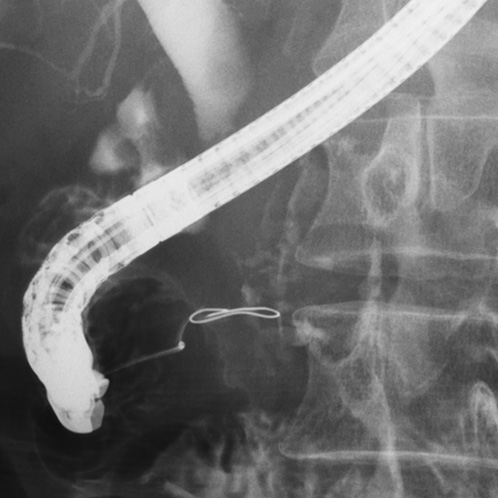Guidewire fracture during endoscopic retrograde cholangiopancreatography is an uncommon event. Very few cases of fractured guidewire within the pancreatic duct have been described in the literature, and the majority of fractured guidewires appears to be irretrievable endoscopically [1]. Herein, we describe endoscopic retrieval of a retained fractured guidewire from the main pancreatic duct.
A 66-year-old man with chronic pancreatitis was referred for recurrent pancreatitis. He underwent endoscopic retrograde pancreatography to place a pancreatic plastic stent, and the pancreatogram showed 3 tight strictures at the pancreatic head (Fig. 1). When we were advancing a 0.025-inch guidewire through the strictures, the guidewire suddenly became unresponsive, and the distal part of the guidewire was retained within the pancreatic duct (Fig. 2). An endoscopic retrieval of the retained guidewire fragment was thus attempted.

Fig. 1 Pancreatogram showing tight strictures at the pancreatic head (arrows) in a 66-year-old man who presented with recurrent pancreatitis.

Fig. 2 Fluoroscopic image showing a retained fractured guidewire fragment within the main pancreatic duct.
First, we barely managed to place a 0.025-inch guidewire (VisiGlide 2; Olympus Medical Systems, Tokyo, Japan) across the retained guidewire fragment. Next, mechanical dilatation using a long-tapered catheter (PR-V220Q; Olympus Medical Systems) was performed. Then, endoscopic pancreatic sphincterotomy was performed to facilitate a smooth insertion of a biopsy forceps. Finally, the retained guidewire fragment was grasped with a biopsy forceps with a diameter of 1.8 mm (Cospa; Century Medical, Tokyo, Japan) and successfully retrieved under fluoroscopic guidance (Fig. 3; online suppl. Video 1, see www.karger.com/doi/10.1159/000516948). Since it took so long to perform the endoscopic retrieval, we decided to do the rest of the treatment on another day. Five days later, we successfully placed a 5-Fr, 5-cm pancreatic stent (Geenen Pancreatic Stent; Cook Medical Japan, Tokyo, Japan) by using the same devices (VisiGlide 2 and PR-V220Q) as initial treatment, and the patient was discharged 3 days after the pancreatic stent placement.

Fig. 3 a Fluoroscopic image showing a guidewire placed across the retained guidewire fragment. b Fluoroscopic image showing the retained guidewire fragment grasped with a biopsy forceps. c A 5-cm fractured guidewire fragment retrieved from the pancreatic duct.
To date, there have been few reports that describe successful endoscopic retrieval of a retained fractured guidewire in the pancreatic duct with a Dormia basket [2, 3]. However, in the current case, the main pancreatic duct was too small in diameter to use a basket catheter. To our knowledge, this is the first report of successful endoscopic retrieval of a retained fractured guidewire from the main pancreatic duct using a biopsy forceps. This case may help with the management of retained guidewire in the pancreatic duct even though the diameter of the pancreatic duct is small.














